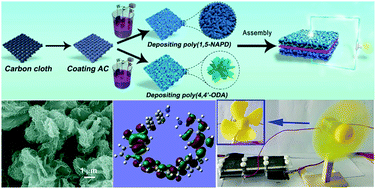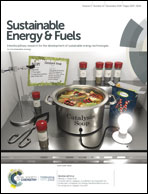Aqueous asymmetric supercapacitors based on electrodeposited poly(1,5-naphthalenediamine) and poly(4,4′-oxydianiline)†
Abstract
An aqueous supercapacitor based on two dissimilar polymers is presented. Negative and positive electrodes are fabricated by electrodepositing poly(1,5-naphthalenediamine) and poly(4,4′-oxydianiline) onto carbon-fabric-supported porous activated carbon coatings, respectively. The asymmetric supercapacitor has a broad voltage window of 1.6 V, high specific capacitance around 600 F g−1 and high mass loading over 10 mg cm−2 for each electrode. The capacitance retention is 91% after 10 000 charge–discharge cycles. The charge storage mechanism accounting for the widened voltage window is proposed.



 Please wait while we load your content...
Please wait while we load your content...